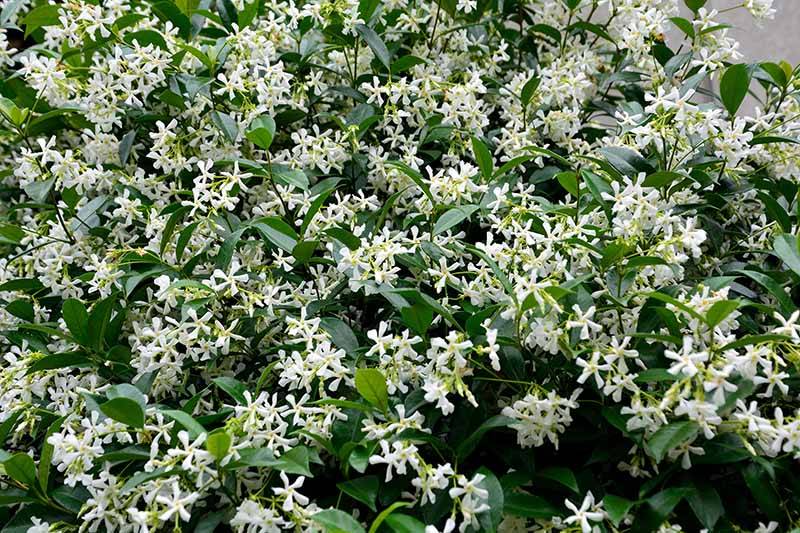
Although Asiatic Jasmine (Trachelospermum Asiaticum) is not related to jasmine plants, it does produce white to yellow, fragrant, star-shaped flowers that resemble jasmine. It is native to Japan and Korea and grows as an evergreen groundcover.
It will form a dense leafy groundcover in two years if allowed to grow continuously through the winter. When grown as a groundcover, it will grow to a height of 6 to 18 inches (15-45 cm) and a spread of 3 feet (90 cm.). It has dark green, small, glossy leaves. It produces small, delicate, and very fragrant flowers in the summer, though flowers may be scarce in hotter climates.
History of Asiatic Jasmine:
Trachelospermum asiaticum has a long history, dating back to 1846 when German botanists Philipp Franz von Siebold and Joseph Gerhard Zuccarini visited Japan and wrote extensively about the plant.
The plant was initially labelled as Malouetia asiatica, but it was later reclassified as Trachelospermum asiaticum by noted Japanese botanist Takenoshin Nakai.
How to Propagate Asiatic Jasmine:
Asiatic Jasmine doesn’t grow from seeds. Let’s discuss what are other propagation methods for this plant:
1. Propagation from Cuttings:
-
This is one of the best ways to grow this plant is to propagate it from cuttings.
-
Take a 5 to 6-inch cutting from the plant's tip. Remove any leaves from the end of the cutting and dip it into some rooting hormone for better results.
-
The plant grows well in almost any soil, as long as the drainage is adequate.
-
Fill a small pot halfway with damp sand or soil and place the cutting in it.
-
Cover the pot with a plastic bag to keep moisture in, and don't forget to water it on a regular basis. Place the pot in a shady or partially sunny location.
-
The cutting can also be propagated in water. After dipping the cutting in the rooting hormone, place it in a glass of water or a bottle.
2. Propagation from Seedlings:
-
If you start propagating or transplanting this plant from seedlings, you can get a green carpet much faster. For a thicker green cover, space each plant 8 to 10 inches apart.
-
Water the plants 3 times per week for the first month, then once per week for the next few months for best results.
3. Propagation from Roots:
-
This technique is also known as layering. While growing, Asiatic Jasmine forms clumps of roots along with the stemp.
-
Simply cut the root and place it in any medium of your choice to allow the plant to grow as an independent plant.
How to Grow Asiatic Jasmine:
Growing any plant successfully needs a certain level of knowledge about the soil required, the amount of sunlight required, fertilizers, and so on. Let's take a closer look at what it takes to grow successful Asiatic Jasmine vines:
1. Soil:
-
As previously stated, Asiatic jasmine thrives in almost any type of soil as long as it is well-drained and has a pH between 5.5 and 7.0.
-
It grows even faster in soil with adequate organic content.
-
Because this is a very sturdy plant, you can plant it in both shady and full sun areas with no problems.
-
If it gets really hot during the summer, watering the plant on a regular basis is the way to go.
2. Water:
-
These vines are drought tolerant and require only moderate watering to thrive in normal conditions.
-
However, if you live in an area where it rains frequently, you can afford to water the plants less frequently.
-
During the summer months, you may need to water them at regular intervals.
3. Fertilizer:
-
Asiatic Jasmine grows quickly without fertilizer as long as the soil is well-drained and has a high percentage of organic content.
-
If you want faster growth, you can use a slow-release NPK 10-10-10 fertilizer during the growing stage.
-
Apply the slow-release fertilizer once a month at first, then once a year once the plant is established.
-
Most Asiatic jasmine vines thrive in the absence of fertilizer.
Best Growing and Caring Tips:
This plant doesn’t require much attention as long as its needs are met:
-
Always use organic-rich, well-drained soil.
-
Place it in a sunny/shady location.
-
During the summer days, water the plants on a regular basis.
-
To promote growth, create a moist and warm environment.
-
If necessary, use a balanced fertilizer.











